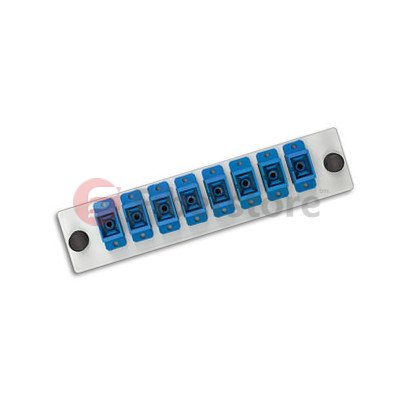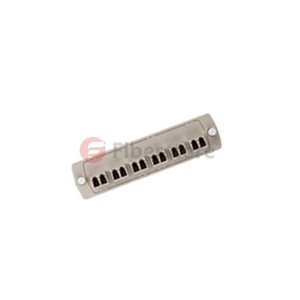A decision must now be made by the enterprise about what physical protocol to use. Currently there are several in use, although Ethernet is the most popular. Each protocol is capable of a different maximum data speed known as the bandwidth, and costs do differ. And install a local area network need what. I will give you some instructions…
Using Fibre Optic Patch Panels
All of the fiber cables that comes from the buildings need to connect the hub. A Fibre Optic Patch Panel is often used as an intermediary. There are many types you can choose from the Fiberstore, such as MTRJ patch panel, and there are also different ports you can choose, 6 port fiber patch panel and 8 port fiber patch panel (shown as the Figure)… All the fiber cables is punched down or attached to the back of the patch. The front is made up of RJ45 connectors into which patch cables connect. This prevents any damage to the room cables because changes do not require the modification of the room cables.
Using Patch Cables
Patch cables, or jumper cables, connect the patch panel to the hubs, connect workstations to the wall jacks, or connect multiple hubs. This allows the network administrator to easily reconfigure the network because all that needs to be modified are the jacks the patch cable connects. The first two types of connections require a straight-through cable. The third requires a crossover cable.
Different cables are needed because of the way twisted-pair cables connect. One pair of cables transmit information in the reverse direction. A hub reverses the cables from a workstation, allowing the lines to match up correctly and straight through to the high speed LAN/WAN system. However, when connecting two hubs, the cables in both is reversed and so both would attempt to transmit on the same pair and to receive on the same pair – thus causing them to be unable to communicate. A crossover cable reverses the transmit and receive lines so that the hubs can correctly communicate.
Using Fiber Boxes and Fiber Patch cables
Just as Fibre optic patch panels and patch cables attempt to percent damage to the fiber cables going out to the buildings, a fiber box and cables do the same for fiber optic cable. The fiber from the other part of the LAN/WAN system connects inside the fiber box and a fiber patch cable is used to connect the box to the hub.
Using the repeaters
Repeaters were the most basic type of active high speed LAN/WAN equipment in the most recent past. They operated solely at the physical layer, receiving a signal on one port, or connection, and rebroadcasting it on all of its other ports. Repeaters could extend a new network beyond the limits imposed by the cables, by boosting the signal level. Today, repeaters are seldom used in new networks. Modern (and more expensive) devices look at the message the signals carry to determine whether they really need to pass each message to the next segment.
Using Fiberstore Patch Panel
Fiberstore patch panel is a special type of patch panel. When connecting rooms, a patch cable runs from the normal patch panel to the Fiberstore patch panel. This connects all of the networks to the Fiberstore patch panel.
If a building has many devices to connect, a good solution is to use a Fiber Box. A fiber box connects to an Ethernet port on a hub and to a Fiberstore patch panel. It converts the packets on the networks into Ethernet packets. This allows workstations on a network to act as if they were directly on the Ethernet network. The fiber Box is a smaller version that can connect to a single network and bridge that network to an Ethernet network.
Finally, maybe someone has interested in the related fiber optical products from the article, it you want to Buy Patch Panel, Fiberstore is good choice. more info you can visit it directly.


